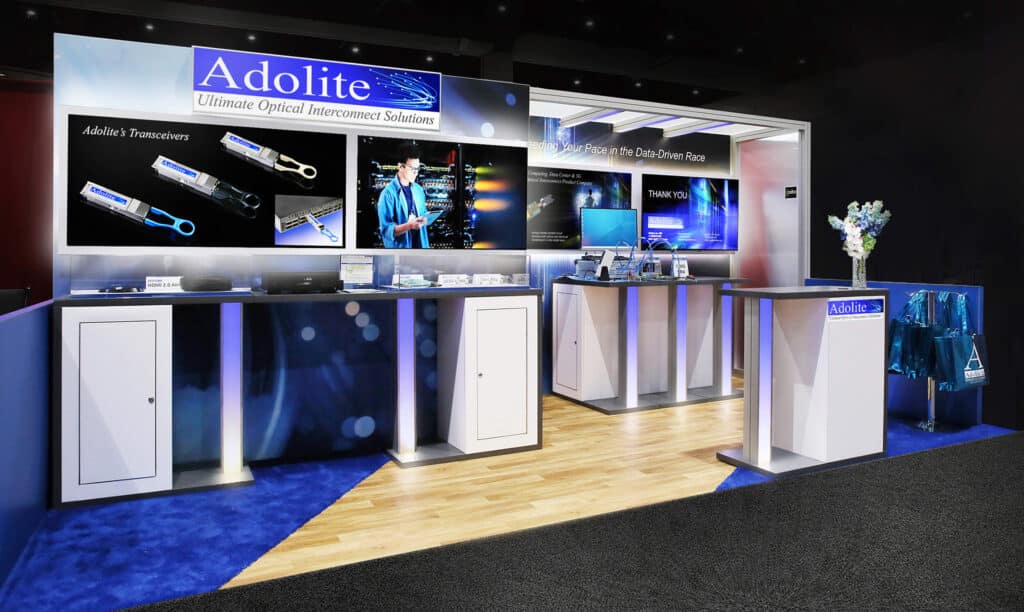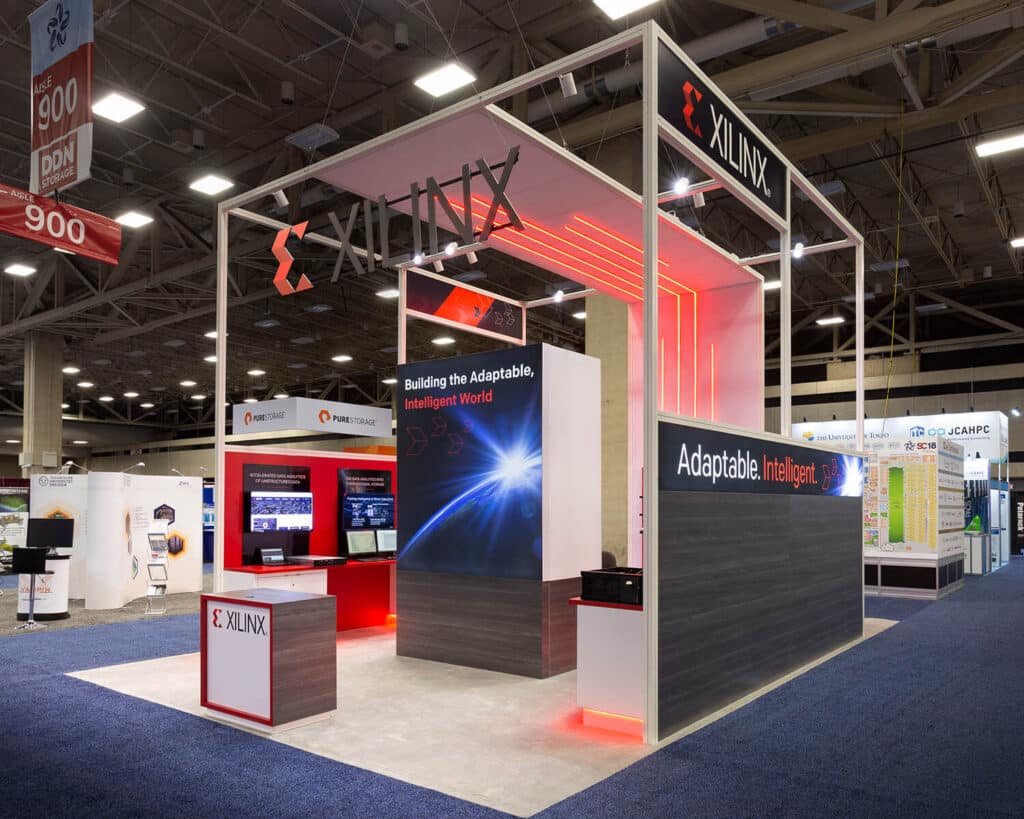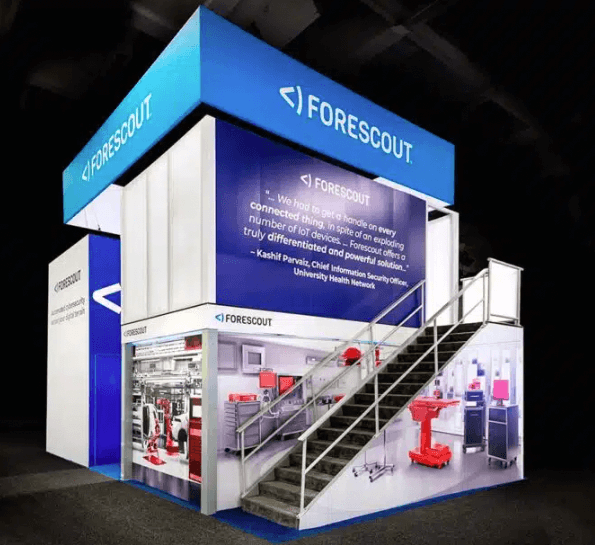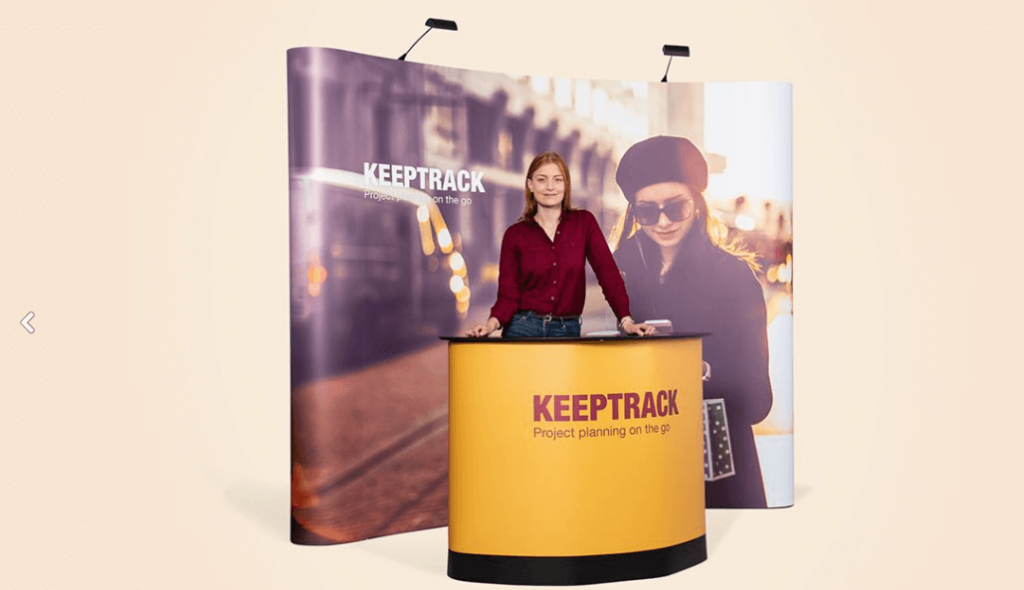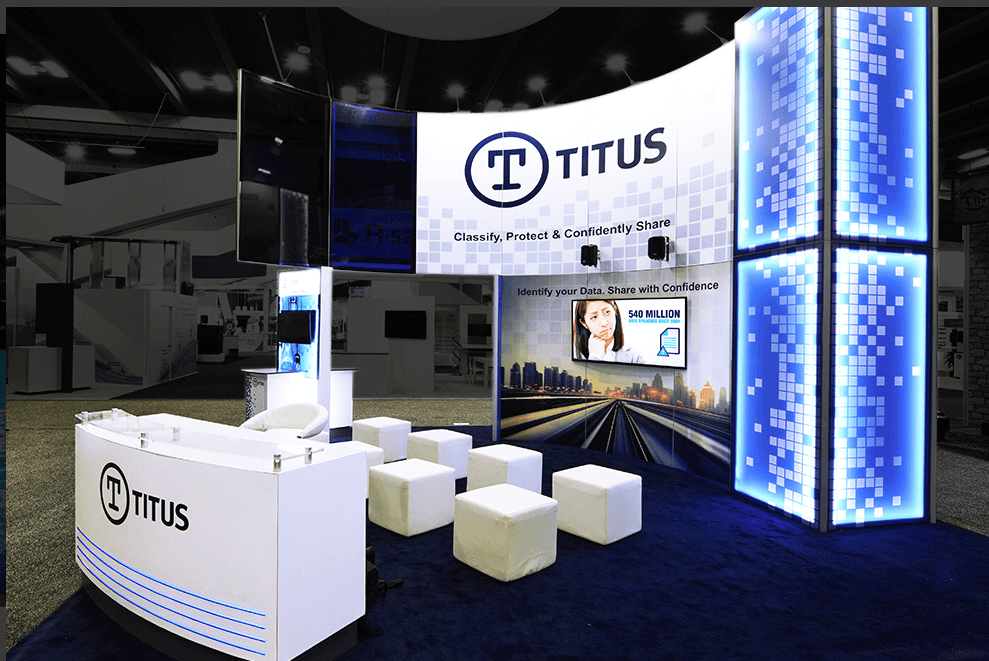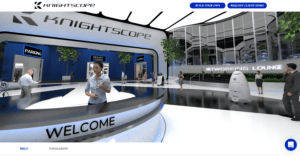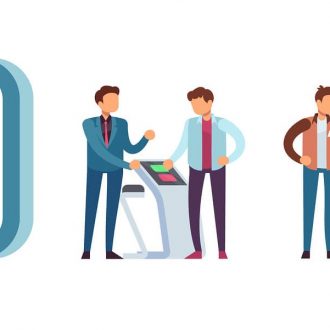Exhibiting at trade shows can provide your company with major business opportunities. But those opportunities and leads will only come your way if your trade show exhibit does its job. That’s why it’s important to keep up with new trade show booth ideas and trends. You’ll benefit not only from more booth traffic, but also from more engaged visitors, which equates to more leads and lasting impressions.
The Best Trade Show Booth Ideas Address These 2 Booth Functions
Companies exhibit at trade shows for a wide range of reasons. Some companies make most of their sales at trade shows. For others, trade shows are the best place to launch new products. Still, the fundamental goals are generally shared, and a trade show booth usually has two functions:
- To entice event attendees to step inside
- To engage booth visitors and funnel them into your sales cycle
Getting the best results from your booth requires that your design and sales strategies address both functions. Attracting hordes of visitors is counterproductive if your trade show display has nothing for them to do. Similarly, if you neglect traffic-boosting strategies and focus only on in-booth engagement, you may end up with fewer visitors than you were hoping for.
Boost Traffic with These Trade Show Booth Ideas
There are two types of trade show attendees:
- People who plan to visit your booth
- People who don’t
The former category includes current clients or customers and others in your industry who know your company. These people already have a specific reason to visit, so you don’t have to worry about enticing them.
The second category is everyone else. They’re people who don’t know your company and don’t know that you have the solution they’re looking for. But if they’re walking around the same expo floor your booth is on, they are potential customers. These are the people that your traffic-boosting strategies must focus on.
Choose the Right Booth Location
Does the success of your trade show booth rely on walk-in traffic? If you’re hoping for a steady stream of visitors, your exhibit location on the trade show floor is an important part of your strategy.
One popular trade show booth idea is to book a space within the “A-triangle.” This is the region of space that’s convenient to an exhibit hall’s most important locations, including:
- The hall entrance and exit
- Restrooms
- Concession stands
If people have to walk past your booth to get to the restrooms or concessions, for instance, you get more eyes on your display and potentially more visitors.
Pro Tip: Competition is often fierce for these spaces, and high-traffic booth locations are priced accordingly. If you’d like to try this strategy, be sure to book your exhibit footprint early.
It can also be useful to consider your neighbors. Try to avoid purchasing booth space located near your biggest competitors. Instead, choose neighbors who complement your brand without competing. If it’s difficult to ascertain who your booth neighbors might be, check the event website for photos from past events. Many companies try to purchase the same booth spaces year after year, so old photos can provide helpful clues.
Provide an Obvious Reason to Visit
Whether it’s free Wi-Fi or a place to sit down for a few minutes, the easiest way to boost traffic is to give people an obvious reason to stop by your booth. There are lots of ways to achieve this, with fun trade show booth ideas suitable for all budgets.
- Offer freebies such as Wi-Fi, bottled water, or local snacks.
- Set up a charging station where visitors can charge their phones.
- Provide seating so guests can get off their feet for a few minutes.
- Pick out desirable swag items to give away.
- Set up a raffle or prize drawing with one or more high-value prizes.
Along with providing a reason to visit, you also need to consider how people will find out about the perks you’re offering. For instance, you can put out one or more signs advertising your snacks or charging station to attract foot traffic. You can also post on social media using the event hashtag. Depending on the trade show, you may also be able to use the event app or website to get the word out.
Station Greeters at the Booth Entrance
People who might otherwise walk on by can often be persuaded to enter your booth if there’s someone there to welcome them in. This role should be chosen carefully. You need a team member who is excited and encouraging, but not pushy.
Create a Vibe
Make your booth look intriguing from the outside by creating a specific atmosphere or vibe. For example, go the fun, party route with games, prizes, and an exhibit emcee. Or do the exact opposite and create a relaxed and restful vibe with comfortable chairs, a “fireplace” on an LCD screen, and even drinks.
Any kind of vibe can work to pull in traffic, providing it’s cohesive and looks good from outside the booth. This means you can choose any theme that works for your brand and messaging.
Trade Show Booth Branding and Design Ideas
Booth design is an essential aspect of attracting and engaging visitors. If your trade show exhibit looks intriguing from the outside, people will naturally want to take a closer look. Go the extra mile to create interesting product displays and other design elements that are clearly visible from outside your booth.
- Build a set piece that shows off the various ways your products can be used.
- Use natural elements, such as water, flowers, or foliage. Organic materials can even be used to build the booth itself, bringing the outdoors to exhibit visitors.
- Incorporate unusual display options. For instance, build a wall of LED screens for a big multimedia display, or display your products using LEGO® bricks.
- Take advantage of vertical booth space by incorporating hanging signs or a second floor for a double-deck exhibit.
- Consider a custom-built booth. If your exhibit needs go beyond the ordinary, going custom can be an effective solution that helps you stand out from the crowd.
- Once your booth is set up, do a “walk-around” to see what it looks like from visitors’ points of view. The elements you want to promote should be visible to people passing by.
Brand Your Exhibit
Trade show booth design is more than looking good. It’s also about making sure your exhibit reflects your brand and company image. Whatever your trade show goals are, branding is integral to the equation. It raises awareness, of course, but it can do so much more. Strong branding makes your booth—and your company—more memorable (brand recognition), which contributes to engagement and can even help drive sales.
- Think more than just logos. Your booth branding strategy should reflect what your brand is all about, whether that’s sleek professionalism or laid-back and casual.
- Every exhibit design decision should be made with the goal of strengthening your brand identity. Don’t just think about what looks good—what does it say about your brand?
- Consider your booth staff. They should be dressed appropriately for the event and reflect your brand identity.
Trade Show Booth Ideas to Increase Visitor Engagement
Once you have people in your booth, it’s time to keep them engaged. When exhibit visitors are engaged, they’re active participants in the experience you’ve built for them. They’re focused on your booth, and that makes them more receptive to your brand messaging.
Lack of engagement means the exact opposite. It’s tough to draw attention and focus from trade show attendees when there’s so much else to look at. But unfocused booth visitors aren’t absorbing your brand messaging. They’re less likely to pick up a brochure, part with their contact information, or pay attention to your sales pitch. Keeping visitors engaged is therefore of paramount importance. Engagement-boosting trade show booth ideas can help you keep visitors in your exhibit for longer. This gives you extra time to make that sales pitch or collect their email addresses.
Boost Engagement with Activities
Once people are in your booth, you want to keep them engaged for the duration of their visit. Activities are a great way to do that, and there are lots of options:
- Booth games can help keep engagement high and provide another option for capturing leads at the same time. A prize wheel, Plinko game, or another similarly-themed game will have people lining up to take part.
- Set up an interactive photo booth with props and filters. Encourage visitors to take photos and post them on social media with your event hashtag.
- Live entertainment at scheduled intervals can pull crowds into your booth and keep people engaged while they’re there. A live band or musician is a natural fit for many shows, but a magician, illusionist, or even a comedian are all viable alternatives
Demo Products
Product demonstrations are invaluable as engaging ways to show people what your products can do. In fact, 92% of attendees surveyed said their primary reason for attending trade shows is to see new products.
But don’t stop at a presentation; let visitors engage with them directly. Being hands-on to experiment with and test your products will cement your offerings in their mind.
Provide Accessible Information
It should be easy for visitors to find information about your company and products. Not every visitor will want to spend time on an interactive display, so don’t hide your brochures in a corner. If people want to pop into your booth just to grab a brochure and then head elsewhere, make sure they can easily do that.
Build Interactive Booth Displays
An interactive touch screen display is a more engaging way to provide company and product information compared to a printed brochure. If you’re going this route, make sure to install enough screens so people aren’t bunched up to use them. And don’t ditch the brochures altogether. They’re great for those people who want to take information away with them.
Embrace Virtual Reality
Not all products are suitable for in-booth demos. And even if they are, trade show attendees are coming to expect virtual reality. A memorable VR experience lets booth visitors see and interact with your products in an entirely new way.
Make Lead Capture Easy
If your objective is to gather leads, make this process as easy as possible for both your booth staff and visitors. One option is to use a lead capture system that lets you swipe a visitor’s ID badge to automatically record their contact details.
A popular alternative is to make lead capture an exchange. Visitors provide their contact details and, in return, receive an entry into a prize drawing for a chance to win a prize. If you offer a high-value grand prize, you’ll almost certainly get plenty of leads with this option.
Booth Footprints Affect Future Trade Show Booth Ideas
In the U.S., booth spaces start at 10×10 feet and size up in increments of 10 feet. The most common booth sizes are 10×20, 10x 30, and 20×20 feet. For big-budget brands that take a peninsula or island footprint, they can get much bigger.
In-Line Booths
This is the most common space and the most affordable. In-line spaces are arranged along the perimeter of the event area or in the interior of the event space in double-sided rows. They’re enclosed on three sides, with the front of the booth facing the aisle.
Most in-line booths are 10×10 or 10×20 feet. They are smaller and less costly than most other footprints. As a result, they’re favored by startups, small businesses, and first-timers.
Peninsulas
The peninsula footprint is designed for placement on an aisle, rather than around the perimeter of the display area. Three of the exhibit’s sides are exposed to the aisle. The fourth side backs up to the adjacent peninsula exhibit. Together, two adjacent peninsulas typically take up an entire aisle. The standard peninsula size is 20×20 feet.
End-Cap
An end-cap is a modified version of a peninsula. In this footprint, the rear side of the end-cap backs up to the rear of an adjacent in-line booth.
An end-cap is typically 10×20 feet in size. With its three exposed sides, the end-cap is a step up from the standard in-line booth, but its smaller size and less prominent location makes it more affordable than a peninsula.
Islands
Island exhibits are the largest, most prominent booths at trade shows. They’re at least 20×20 feet and are often much larger. Typically reserved by the biggest corporate brands, these tend to be the flashy booths that attract visitors galore. Islands are completely free-standing and, depending on the booth design, may allow access to foot traffic from all four sides.
Double-Deckers
Like the name suggests, double-decker exhibit designs are laid out over two floors. This can be a good way to add more room to your exhibit without increasing its footprint. It’s also quite eye-catching.
Not all exhibit types can accommodate a double-decker design. Typically, a booth needs to be at least 20×20 feet to support a second floor. Another issue is that some shows limit the amount of vertical height you can use. Before you start exploring double-decker trade show display ideas, confirm with the show managers that there’s enough height room available.
Types of Exhibits for Your Next Trade Show Booth Idea
Tabletop Displays
If your company is exhibiting at a trade show for the first time, chances are you’re working with a pretty small budget. Using a tabletop display can help you avoid overspending. While these displays are small and have limited “wow” potential, they can easily meet the needs of most first-time exhibitors when much of your reason for attending is to get your name in front of leads.
Portable
Portable exhibits are useful for first-time exhibitors because they’re lightweight and convenient to set up. Ease of install and dismantle means you can probably do them yourself and save on set-up costs. And because they’re lighter, you also save on shipping and drayage.
The main downside of portable displays is that because they’re designed for simplicity and convenience, they lack the features that give larger displays their impact. But, for the money, they do a great job. And a well-designed portable display can make a good impact and help you get your brand message out there.
Mobile
A mobile exhibit takes portability to the next level. With this kind of exhibit, you have the chance to take your brand out of the exhibit hall and on the road. A mobile display is a vehicle, such as an RV or van, customized to be a travelling exhibit. Larger exhibits are in the form of an expandable trailer, hauled by a semi-truck. Once parked, the trailer is expanded to provide lots of exhibit room.
A well-designed mobile exhibit can be highly powerful. It allows you to take your message wherever you want, any time. You’re not constrained by an exhibit schedule or location. The entire vehicle—inside and out—can be fully customized to promote your brand. It can even be customized for different functions, such as:
- Video conferencing and media screening
- Sales demonstrations
- Training
- Classroom sessions
Modular
Modular exhibits are made up of separate components. They can include a range of different pieces, including:
- Display shelves and cabinets
- Demonstration tables
- Banners
- And more
The modular exhibit doesn’t fit into a specific footprint. Instead, you choose the footprint and then select components to fit the space. This gives you a lot of flexibility to decide what your trade show display needs. Another plus is that a modular booth is easy to up- or downsize according to the space you have available.
Pre-Fabricated Rental Booths
What if you want a large or elaborate booth but don’t want the expense that comes with it? One possible solution is a pre-fabricated rental booth. This exhibit is made to fit into a particular space and comes with a set list of components. You pay the rental fee and get everything that comes with the booth.
This can be a highly convenient way of getting a well-made, eye-catching trade show display at a fraction of the purchase price. And if the rental company is willing to take care of shipping, drayage, and set-up, all you need to do is show up at the show day of.
Custom Exhibits
If your exhibit philosophy is along the lines of “go big or go home” and you have the budget to match, why not consider a custom exhibit? Whatever your needs are for a trade show exhibit, going the custom route ticks all the boxes. It’s built according to your own specifications, so you know exactly what you’re getting and how much it will cost.
And just because you choose a custom design doesn’t mean you’re committed to a single footprint. A good design company can work with you to design an adaptable, creative trade show booth that fits into multiple booth footprints.
Note that while many companies choose to have a custom exhibit purpose designed and built, it’s possible to rent a custom exhibit too. For instance, at ProExhibits, we have a large selection of exhibit rentals we can retrofit to your specifications. This gives you a custom exhibit without the higher outlay of a custom design.
High-Impact Trade Show Booth Ideas Make Every Visitor Count
There are lots of decisions to make when exhibiting at trade shows. From trade show booth design and location to content and marketing messages, all these choices are an integral part of your trade show success. Make the ones that have a positive impact on booth traffic and audience engagement to achieve the best results for your booth and your company.
Overwhelmed with ideas? Not sure you’re landing on the right ones? The team at ProExhibits can help. Contact us today!

